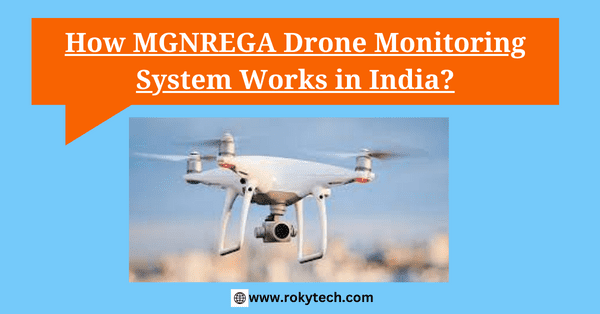In this article, we are giving information about How to Work the MGNREGA Drone Monitoring System in rural development areas. The Government of India has released an SOP for Drone Technology used especially monitoring the MGNREGA Scheme.
So in this topic, we will provide information on How Drone Technology are used in Monitoring MGNREGA works. Let us start with the topic.

As you know MGNREGA is an Act or is a social welfare program in India that guarantees wage employment to rural households. While I don’t have information on developments beyond that date, I can provide an overview of how drone technology was used for monitoring MGNREGA works in India.
Drones offer several advantages for monitoring such projects:
1. Aerial Surveillance: Drones can capture high-resolution aerial imagery and videos of work sites, providing a comprehensive overview of the ongoing activities. This helps in assessing the progress and quality of work.
2. Data Accuracy: Drones can provide accurate geospatial data that can be used to measure distances, areas, and volumes, which is crucial for monitoring and quality control.
3. Efficiency: Drones can cover large areas quickly and efficiently, reducing the time and effort required for manual site visits.
4. Transparency: The captured imagery and data can be shared easily with stakeholders, ensuring transparency in project execution.
5. Remote Accessibility: Drones can reach remote and inaccessible areas, allowing for monitoring of projects that might otherwise be difficult to oversee.
Here’s how drone technology has been applied to monitor MGNREGA works in India:
1. Progress Monitoring: Drones capture images and videos of the ongoing MGNREGA projects. These visuals are then compared against the project plans and timelines to monitor the progress of the work.
2. Quality Assessment: Drones can capture detailed images of construction and development projects, helping authorities assess the quality of work being done.
3. Geotagging: Drones can provide geotagged images, which are photos with geographical metadata. This helps in verifying the location of the work and preventing any potential fraud.
4. Resource Allocation: By analyzing drone data, authorities can make informed decisions about the allocation of resources and manpower based on the actual progress and requirements at different sites.
5. Verification of Assets: Drones can aid in verifying the creation of tangible assets like ponds, roads, and water conservation structures under MGNREGA.
6. Reducing Leakages: Drones can assist in identifying ghost beneficiaries, where payments are made for work that was not done.
7. Evidence and Documentation: High-resolution imagery and videos captured by drones can serve as valuable evidence in case of disputes or discrepancies.
It’s important to note that the adoption of drone technology for monitoring MGNREGA works may vary from state to state and region to region in India. Additionally, regulations, technological advancements, and government policies might have evolved since my last update.
As you also know the Government recently started online NMMS labour attendance during the wage demand of any works in NREGA soft. So the concerned official person has to take attendance at the time of work in the field and also be required to upload a photograph of the labour. Any person may view NMMS Attendance online directly from the official website of MGNREGA.
How to Use the MGNREGA Drone Monitoring System?
Drone may be used for regular monitoring as well as special inspection. To leverage the use of Drones, it has been proposed to use this technology for monitoring and inspection of works and the quality of assets under Mahatma Gandhi NREGS.
Following are the proposed activities that should be carried out by using a drone:
- Monitoring of ongoing works drone may be used for monitoring ongoing works by capturing geo-referenced
image before the start of work and during the execution of the work. - Inspection of completed work- A drone may be used to get the real-time status in all respects of the created assets
by capturing geo-referenced images of the completed work. - Impact assessment of the completed works with different time series data impact assessment of NRM, Water and Agriculture works may be done.
- Special inspection- A drone may be utilised for enquiring complaints against the work/asset.
Who can use the MGNREGA Drone Monitoring system?
We already know MGNREGA has a provision that there shall be an Ombudsperson for each District to receive grievances, enquire into and pass awards as per the Ministry’s guidelines on Ombudsperson. The Ministry’s objective is to establish a system for the redressal of grievances and disposal of complaints relating to the implementation of the Mahatma Gandhi NREG Act and the Schemes.
Also, the cases of denial of entitlements as brought out through social audits shall also be referred to the Ombudsperson by the Social Audit Unit. The Ombudsperson shall be responsible for registering the same as suo moto complaints for disposal and passing awards within 30 days from the date of filing of the complaint as per the laid norms.
For efficient monitoring and redressal of grievances, it is decided by the Ministry that, the Ombudsperson may use Drone technology facilities for verification of the works virtually. This facility will help Ombudsperson to pass the award in time a bound manner. Therefore, the State Government should provide drone facilities to Ombudsperson for timely redress of complaints against a demand by the Ombudsperson.
On request of the Ombudsperson State should provide the service of drone and the related required items for inspection of the work site Livestream at the district headquarters.
The expenditure on the drone service for the Ombudsperson shall be booked under the administrative head of the Mahatma Gandhi NREGS at the district level.
The Ombudsperson may be provided the services of a drone within 15 days of the request. Due to any technical reason, if the service is not provided then s/he will have to visit the work site and monitor the work physically on the field as required.
Who can also be a Monitor?
- Monitoring by Programme Officer, District Programme Coordinator, DRDA
- Monitoring by DISHA
- GeoMGNREGA: Geotagging assets in three stages (Before, During and after)
- Social Audit, Ombudsperson
- Internal Audit
- Monitoring through the Area Officers App
- Common Review Mission
- National level Monitors: – regular as well as special monitoring
- Grievance Redressal Mechanisms, CPGRAMS
- Janmanrega App: A citizen-centric feedback-based monitoring
Who is the Custodian of Capturing video and imagery?
All videos and images through drones should be shared with the NREGA Soft. The uploaded videos and images are required to be saved in the database for 15 days. If the State/ Districts want to collect and save the information of any work site for any particular reason, they may download and save it to their local database within 15 days.
The drone report will be in the form of videos (MP4 format) and imageries (JPEG or TIFF format) along with the respective remarks/observations.
Conclusion:
In the above article, we get some valuable information about the MGNREGA Drone monitoring system in rural development works to be implemented in the states and as well as every district. We hope this article may help you with some extra information about the Mahatma Gandhi National Rural Employment Guarantee Act (MGNREGA) Drone Technology system.
Read More- How to Check PMAY-G House Instalments?




